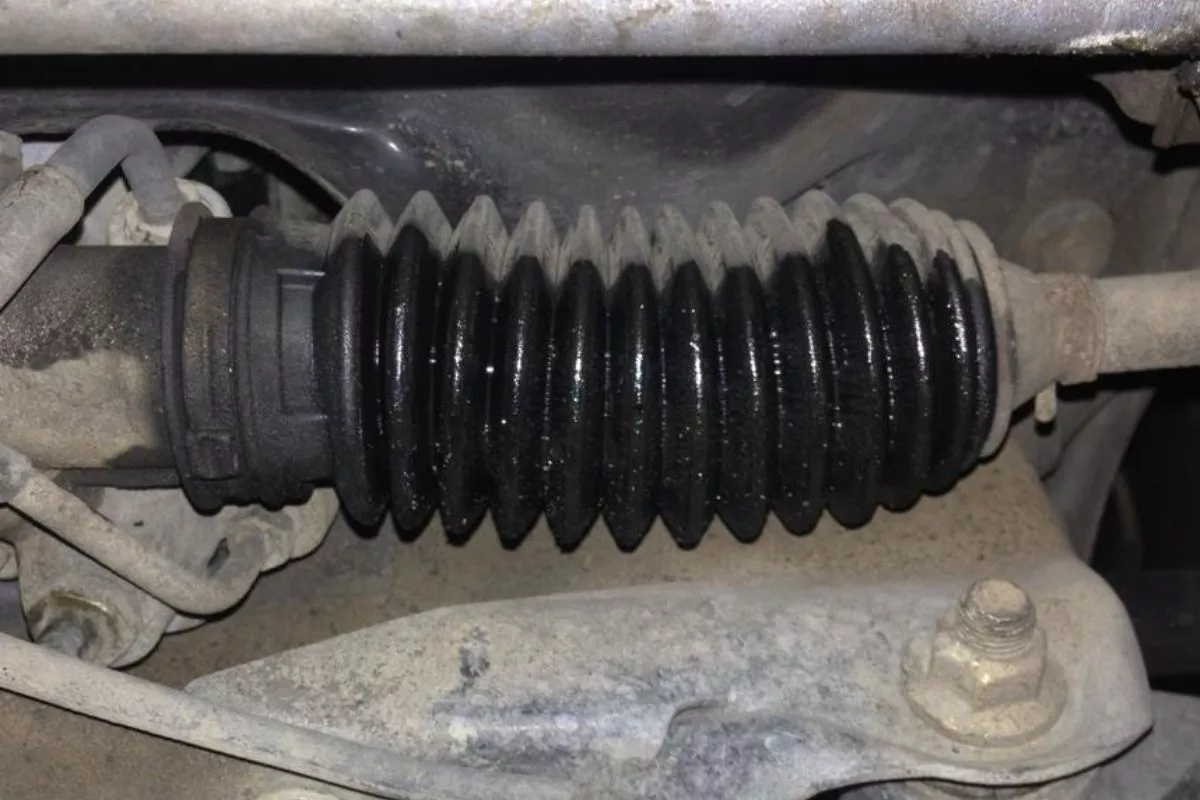If you’re driving a car that was built within the past 50 years, its steering system probably uses a rack and pinion. It works by translating the motion of a steering wheel into side to side, or linear motion which turns the car’s wheels. To do that, the steering shaft is linked to a gear, or pinion gear, which in turn moves along a rack.

Here's a simplified diagram of a car's rack and pinion
As most moving parts inside a car, the rack and pinion need oil to run properly. Oil after all, ensures less friction making the act of turning the wheel smoother. Of note, this oil is kept in high pressure inside the rack and pinion especially on power steering systems.
Again, as with most moving parts that use oil, they will leak. There are several reasons as to why, but a rack and pinion without or with a less than ideal amount of oil can prove dangerous to you since it’s one of the major components of your car’s steering.
So, without further ado, here are several symptoms you can watch out for in relation to rack and pinion leaks.
Power Rack and Pinion Steering System
Rack and pinion leak symptoms
Symptom #1: Steering wheel is hard to turn
One obvious rack and pinion leak symptom is a harder or heavier steering wheel. If the hydraulic steering systems can’t get enough oil, you’ll have unassisted steering. Hydraulic systems like this, will of course need pressure to circulate oil. With a leak, that pressure is good as gone.

Usually, cars with power-steering allows for steering the wheel with one hand
Symptom #2: Grinding noise
Another symptom of a rack and pinion leak is grinding sounds coming from the pinion gears. This is because the leak might be robbing the said gear of oil that it needs for lubrication.
Symptom #3: The steering wheel doesn’t center
When the rack and pinion is working correctly, a steering wheel should go back to its default center position by itself while the car is moving forward.
>>> Related: 7 Signs of a Bad Steering Wheel and How to Fix Them
What causes power steering rack and pinion leak?
Like most pressurized components in a car, the rack and pinion will have several gaskets. This ensures that the system can keep the pressure for the oil to flow. At the same time, it also prevents the oil from escaping. With a bad gasket, the oil will slowly find its way outside the rack and pinion.
Why do gaskets go bad? Well, as mentioned, they are constantly keeping pressure in. Irregular high pressure can cause the gaskets to go bad. Seals will also shrink and crack due to extreme weather conditions. When that happens, they will unseat themselves thus causing a leak.

A leaky gasket up close
Another thing that can cause power steering rack and pinion leaks are dirty or contaminated oil. Once contaminated with either water, dust, or other substances, the seals and gaskets in a steering system will wear down. They might even increase pressure causing damage to the pinion gear itself.
Moving on, a broken drive belt or damaged steering pump can also cause damage to the rack and pinion seals. On top of that, a broken belt will fully deactivate your power steering pump since it draws power from the engine with the said belt.
And lastly, too much force can break the rack and pinion, and many other components of the power steering system. This might come in the form of potholes, rough roads, road bumps, etc.
>>> Related: Quick & easy guide to unlock your steering wheel
How to fix a leaking rack and pinion?
For the most part, fixing a rack and pinion leak is quite expensive. Why? Well for starters, looking for the leaking gasket or seal is a time-consuming process. One has to disassemble the steering system, and trace the path of the oil, and/or check every single gasket. Sometimes, the gasket doesn’t even look broken but for some reason still leaks.

In some instances, a mechanic will need a hydraulic lift to access the rack and pinion
To this end, we recommend approaching a mechanic who knows what he’s doing. Sure, some talented amateur mechanics can perform this fix at homes, but it involves a lot of time. You might even need a hydraulic lifter to properly gain easy access to the rack and pinion.
Also, replacing the entire rack and pinion is a common solution to leaking, especially if you want to save time.
>>> Related: What to ask your mechanic so you can save more money?
Rack and pinion repair costs
For older vehicles, rack and pinion repair labor costs can range from Php 1,000 above. A replacement rack and pinion’s cost will depend on the car model. A surplus one for a 1990s Toyota Corolla however can cost somewhere from Php 3,000 above.
Parts for newer cars are much more expensive. Also, larger models with steering systems will command higher prices. Take for example 2012-2016 Toyota Altis. Its replacement OEM rack and pinion set can cost somewhere around Php 10,000.
For more helpful car maintenance tips, keep reading here on Philkotse.com.
Rack and pinion leaking: FAQs
1. Is it better to just replace the damaged rack and pinion instead of repairing it?
Answer: In some cases, it is better to replace the rack and pinion instead of fixing the leak. It can be more cost-effective, and might even save time.
2. Can I drive with a faulty rack and pinion?
Answer: No, we do not advise driving with a faulty rack and pinion.
3. Can I drain the rack and pinion oil?
Answer: Yes, you can drain the rack and pinion oil. To do this, remove the inner end of the lower gaiter then pull it out of the rack drain.
4. Can I use automatic transmission fluid for power steering?
Answer: Yes, you can use ATF for power steering systems. Just make sure by checking the car manual, and the labels on the ATF.
5. What do I do if my steering fails while driving?
Answer: If you’re traveling at speed, slow down. Apply brakes lightly and let others know that you’re having trouble. You can do this by turning on your hazard lights. Once stopped, place your early warning devices.
Recent posts
- Engine oil myths and what to do when oil leaks happen Aug 17, 2022
- A guide with 4 DIY steps to deal with car radiator leak Aug 17, 2022
- 4 steps to take DIY leak down test Aug 09, 2022
- How to flush and bleed power steering systems like an expert Mar 09, 2021
- 4 Hacks on How to Find Car Air Conditioner Leaks Jul 19, 2018












